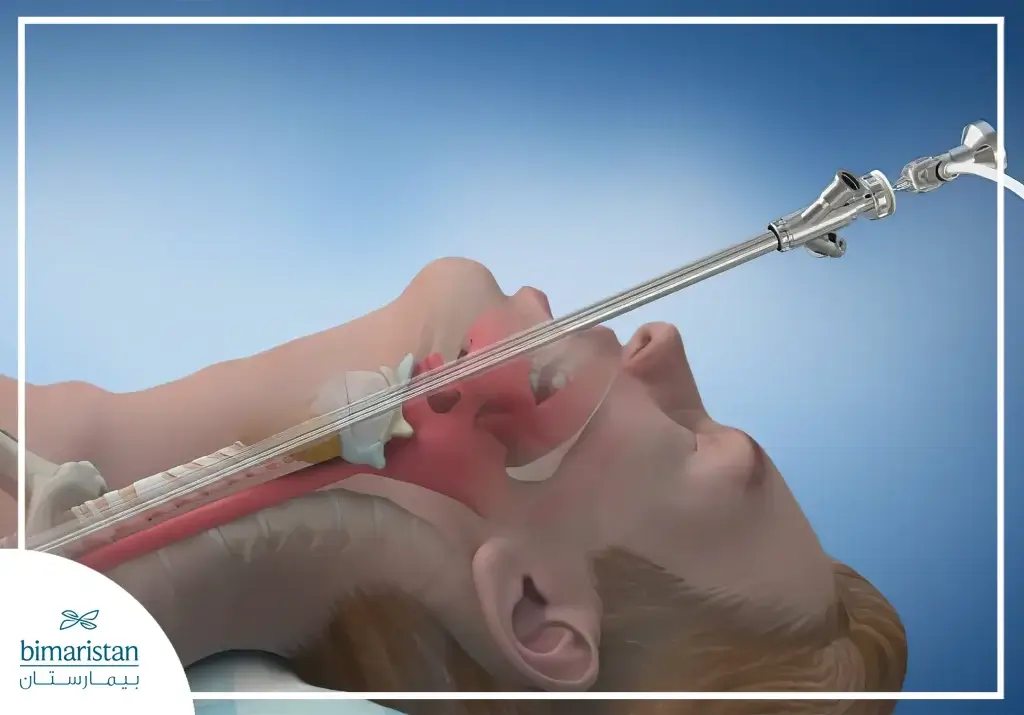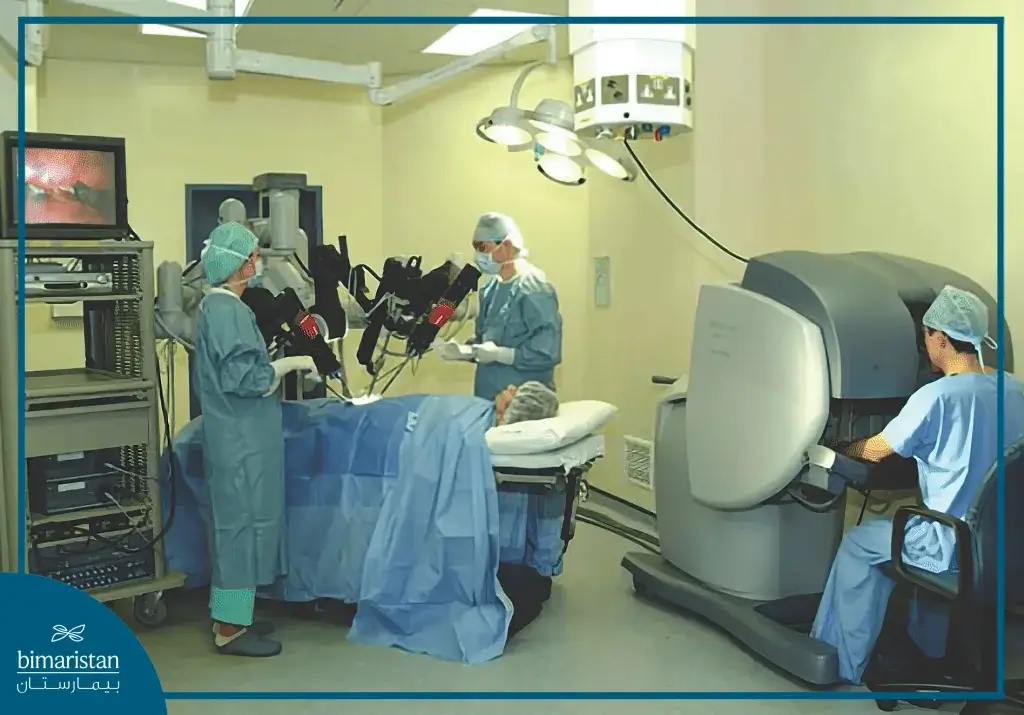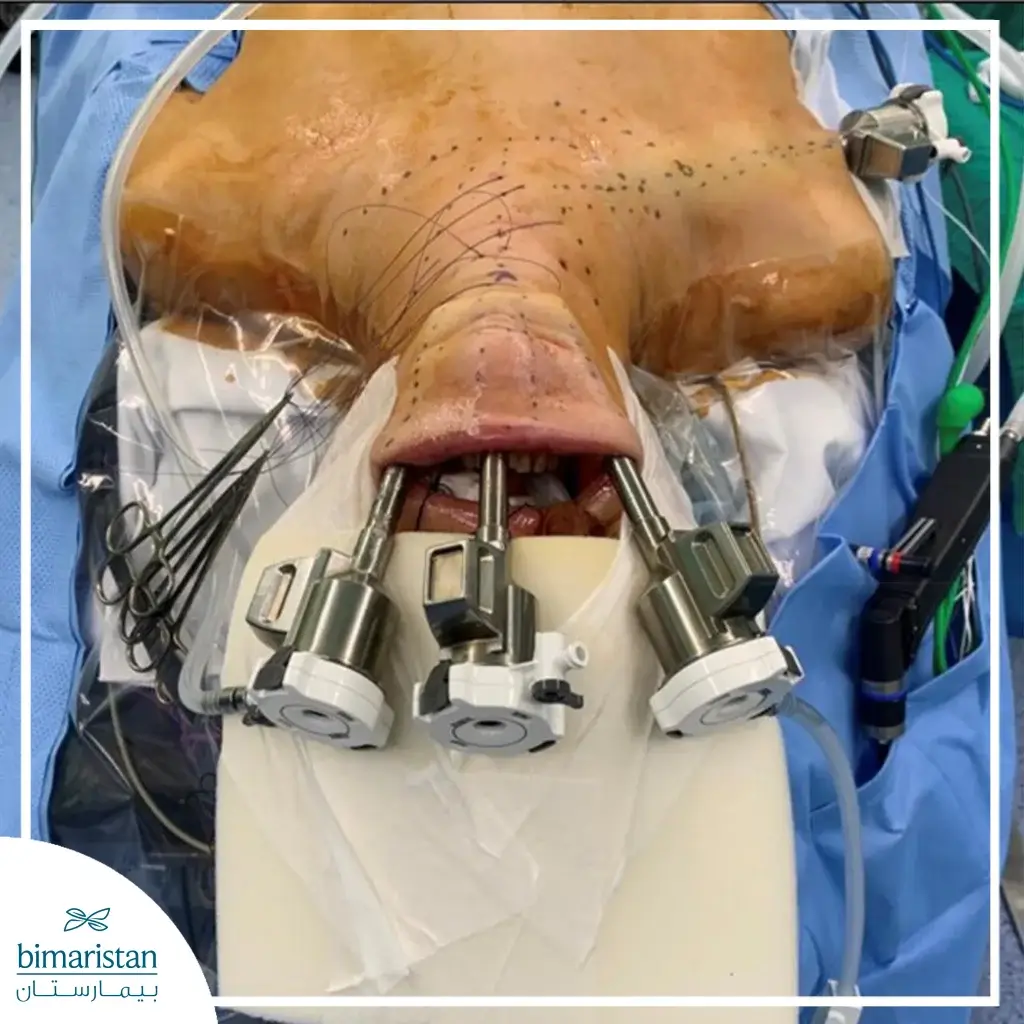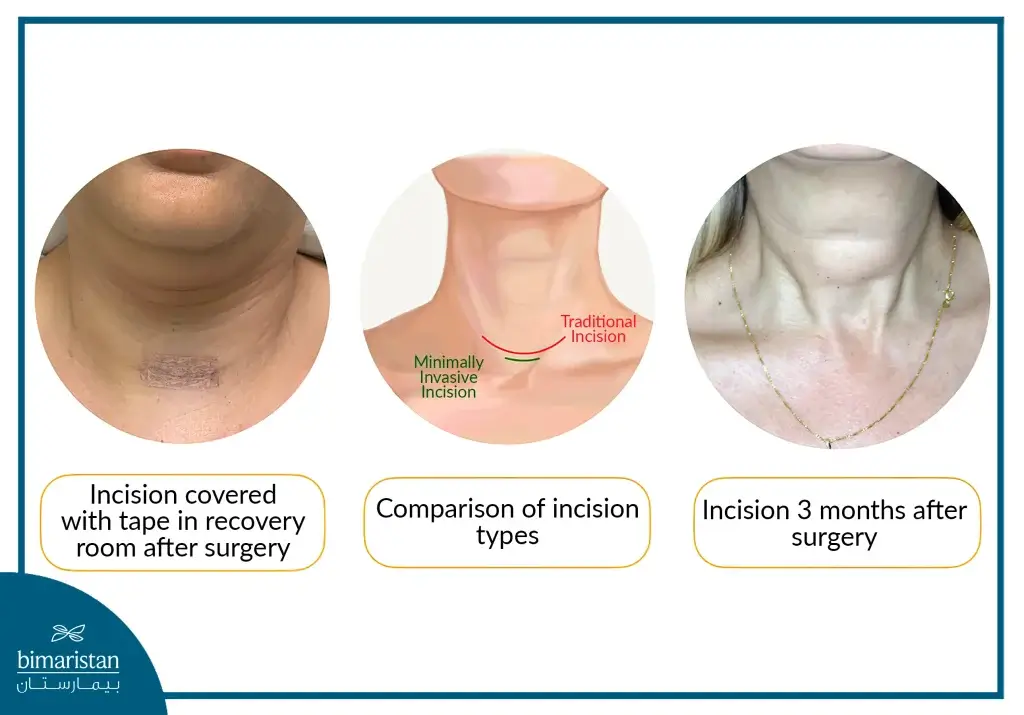The field of surgery has witnessed a huge boom in recent years with the introduction of robots into operating rooms. These robots have revolutionized treatment methods and contributed to improved surgical outcomes. Among these notable developments, robotic thyroidectomy in Turkey is one of the most advanced and safe procedures.
Turkey is a leading country in adopting modern surgical techniques, providing an advanced medical infrastructure and highly qualified and experienced medical personnel. This type of surgery combines high precision with minimal surgical intervention, which reduces complications and speeds up the recovery process. In this article, we will learn about the advantages of using robots in thyroidectomy surgery in Turkey, the technological innovations that support this type of surgery, and patient experiences that highlight the benefits and advantages of this advanced treatment approach.
What is thyroidectomy?
Thyroidectomy is a surgical procedure that involves removing all or part of the thyroid gland. This operation is performed in certain cases when the thyroid gland is affected by serious diseases such as thyroid cancer or when it has significantly enlarged.
When should the thyroid be removed?
The thyroid gland is removed in the following cases:
- Enlarged thyroid gland
- The presence of thyroid tumors:
- Thyroid nodules
- Thyroid cancer
- Hyperthyroidism
What happens after thyroidectomy?
After thyroidectomy, the patient can return to his everyday life with some of the following precautions:
- Taking painkillers or anti-inflammatory medications
- Regularly taking the medicines suggested by the doctor
- Practicing some neck-tightening exercises
- Avoid strenuous work
- Avoid some fatty and greasy foods
Complications of thyroidectomy
- Temporary voice changes
- Accumulation of some questions
- Bleeding may occur
- Difficulty swallowing
A new option for thyroid surgery
There is a new treatment option for patients who need thyroid surgery, which is a robotic thyroidectomy.
But this does not mean that the robot performs the surgery.
Robotic thyroidectomy means you won’t have a scar on your neck, and for many people, that’s reason enough to try this newly developed surgical technique.
In this article, you’ll learn more about the details of robotic thyroidectomy and whether it’s a surgical option for your thyroid disorder.

Robotic Thyroidectomy Development
Robotic thyroidectomy—a minimally invasive surgical technique for removing all or part of the thyroid gland—was developed by doctors in South Korea. It can also be called robotic-assisted thyroid surgery or robot-assisted laparoscopic surgery.
Robotic thyroidectomy is a logical next step in thyroid surgery. Before its development, there were two main options for thyroid surgery: traditional open surgery or laparoscopic surgery.
Traditional open surgery involves a scar on the neck, while laparoscopic surgery may or may not leave a scar on the neck.
Open thyroid surgery, or standard or traditional open surgery, requires a 4-6 cm incision for most patients, although some surgeons operate through a 3 cm incision.
For many years, this was the only technique available for thyroidectomy, where the surgeon exposes the entire thyroid gland so that he can directly see the gland and what needs to be removed.
Open surgery led us to laparoscopic surgery, a minimally invasive technique in which the surgeon uses a small camera to see what he is working on while performing surgery with special instruments.
There are different methods available, but most involve making an incision in the neck, which leaves a 2-3 cm scar that can disfigure the neck, even in the best of cases.
Robot-assisted surgery has been performed on other parts of the body, such as prostatectomy and hysterectomy. However, robotic thyroidectomy is the first time that robotic surgery has been performed on the head and neck.
One of the first studies on robotic thyroidectomy was published in March 2009 – as you can see, it is a recent development indeed.
More studies are being released as more doctors report their experience and success with this new technique.
Introduction to Robotic Thyroid Surgery in Turkey
Traditional (old) thyroid surgery results in an easily visible and undesirable scar on the neck, which is very noticeable and repulsive to some people.
However, with entirely new techniques invented in the last four or five years, thyroidectomy can now be performed with results ranging from invisible scarring to no scarring.
There are two main scarless methods:
- Robotic Thyroidectomy
- Laparoscopic Thyroidectomy
Scarless thyroidectomy uses a modern robotic technique to treat thyroid nodules and cancers, while laparoscopic thyroidectomy uses a camera and instruments similar to the laparoscope used to remove the gallbladder.
For almost all patients who want to have a scarless thyroid operation, the robotic method is preferable.
How does robotic thyroidectomy work in Turkey?
Robotic thyroidectomy does not cause a neck scar because the thyroid gland is accessed through an incision under the arm – another very small 5 mm incision is made in the chest – this is called the axillary approach.
This incision is 5 to 7 cm long, but it is hidden and not visible like the neck scars that result from open thyroidectomies or even most laparoscopic thyroidectomies.
Thyroidectomies are performed using the da Vinci Surgical System, which has been used successfully in many other robotic surgeries.
The da Vinci System contains:
- Four robotic hands:
Called EndoWrists, they work just like hands, can grip, bend, and rotate objects, and are incredibly small.
The robotic hands allow the surgeon to make exact movements.
- 3D camera:
This is a high-resolution camera that gives the surgeon a 3D image of the thyroid gland. He can zoom in and get a more detailed look; the camera has a 10x magnification.
- Control panel:
The surgeon sits at a console, controls the four robotic hands, and sees the images from the 3D camera.
The four robotic hands and the 3D camera are inserted through the incisions.
The surgeon can then carefully remove part or all of the thyroid gland, depending on the patient’s condition.

To reassure you, the da Vinci robot is completely under the surgeon’s control, and the robotic hands cannot move independently; the surgeon must tell them what to do.
The da Vinci surgical system cannot be programmed either; the surgeon must be present to make interventions and decisions during the removal procedure.
Scarless robotic thyroid surgery has only become successful in the past five years, and surgeons worldwide have tried several different techniques to avoid visible scars on the front of the neck.
These scars often remain visible for many years and cause embarrassment for many patients.
Scarless thyroid surgery involves dissecting and removing the thyroid gland and placing the resulting scar in an out-of-sight location – such as the armpit – so that no scar is visible on the neck.
Scarless thyroid surgery techniques aim to achieve the same successful results as conventional surgery while achieving cosmetic satisfaction and confidentiality for patients, and depending on this technique, many benign and cancerous conditions of the thyroid gland can be treated.
Read the comprehensive guide about: General Surgery in Turkey
Advantages of Robotic Thyroidectomy
- No incision in the neck
- The surgeon can get a better view than in traditional open surgery. In traditional open surgery, the surgeon looks at the thyroid gland from top to bottom, making it somewhat difficult to see deeper structures, such as the recurrent laryngeal nerve. The 3D camera gives a magnified view, and using this technology allows him to look directly at the thyroid gland.
- Better positioning of high-risk structures: The magnified 3D view makes it easier to identify high-risk structures, such as the recurrent laryngeal nerve (the nerve that connects to the larynx) and the parathyroid glands.
- Better dexterity in certain areas: The robotic instruments give the surgeon 6 degrees of freedom of movement, allowing him to maneuver certain parts of the thyroid gland more easily.
- Less complicated: It does not require inflating the surgical area with carbon dioxide, as in conventional laparoscopic surgery, where carbon dioxide is inflated in the neck area to expand the area around the thyroid gland to allow better access. This can cause swelling in the neck after surgery.
- Recovery time for robotic thyroidectomy is about the same as for open or laparoscopic surgery – the patient usually spends one day in the hospital after surgery.

Disadvantages of Robotic Thyroidectomy
The only drawback of robotic thyroidectomy at this time is that it cannot be used in every patient.
Who can have a robotic thyroidectomy?
Robotic thyroidectomy is not a treatment option that can be performed for everyone, but as technology improves, more people may be able to have this surgery.
Right now, robotic thyroidectomy works best for patients who:
- Are not overweight
- Have a small thyroid gland (4 cm maximum)
- Have small nodules (2 cm maximum)
- Have nodules on only one side of the thyroid
If you need to have your thyroid removed, talk to your doctor about robotic thyroidectomy.
Find out if it is an option for you.
Regardless of your treatment options, always ensure you fully understand the risks and benefits. Ask all the questions you need so you know what will happen before, during, and after surgery.
Robotic thyroid surgery is a good option for almost all patients needing thyroid surgery.
Patients with thyroid nodules and goiter are ideal candidates for robotic thyroid surgery. At least half of thyroid cancer patients are good candidates for robotic thyroid surgery as well, provided they have a very experienced surgeon who has performed many robotic thyroid surgeries.
In the sections below, we will discuss the types of patients who are very good candidates for robotic thyroid surgery.
Robotic thyroid surgery for thyroid tumors
Robotic thyroid surgery is suitable for most small to medium-sized thyroid tumors that require unilateral or bilateral resection, including those requiring central and lateral neck dissection.
No scarring and cure rates are on par with traditional open thyroid surgery.
Robotic Surgery for Thyroid Nodules
Scarless thyroid surgery is ideal for thyroid nodules less than 6 cm in diameter, whether functional or not, or if there is concern for unilateral or bilateral malignancy – both are excellent candidates for robotic thyroid surgery.
Robotic Thyroid Surgery for Goiter
Robotic thyroid surgery enables patients with goiters of almost any size who wish to avoid a neck incision and the resulting scar.
Can thyroidectomy be performed with a laser?
Yes, thyroidectomy can be performed using laser-guided technology. It is a modern, non-surgical technique to remove part of the thyroid gland without traditional surgical intervention.
Endoscopic Thyroidectomy
Yes, the thyroid gland can be removed using the endoscopic technique. Endoscopic thyroidectomy is a modern surgical procedure that uses the endoscopic technique to remove the thyroid gland or part of it.
Read more about: Endoscopic Pituitary Surgery
Neck shape after thyroid surgery

Thyroidectomy Price
The price varies based on the following factors:
- Type of surgery
- Doctors’ experience
- Location or country where the surgery will be performed
Robotic Thyroid Surgery for Graves’ Disease
Scarless robotic surgery is ideal for female patients with Graves’ disease, allowing them to recover without a scar on their necks.
Tips after thyroidectomy
Thyroidectomy is a surgical procedure that requires special care after the operation to ensure a quick and effective recovery. Here are some important tips to follow after thyroidectomy:
- Complete rest:
- Make sure to get complete rest in the first few days after the operation. Avoid strenuous physical activities and elevate your head while sleeping to reduce swelling.
- Take prescribed medications:
- Stick to taking the medications prescribed by your doctor, especially thyroid hormone replacement, if prescribed. Do not stop taking your medications without consulting your doctor.
- Wound care:
- Keep the wound area clean and dry. Follow your doctor’s instructions regarding changing bandages and wound care.
- Avoid strenuous activities:
- Avoid lifting heavy objects or engaging in violent sports for a certain period after the operation, to prevent any pressure on the wound.
- Monitor symptoms:
- Be aware of any abnormal symptoms such as severe pain, excessive swelling, or any signs of infection such as redness or abnormal discharge from the wound. Notify your doctor immediately if any of these symptoms appear.
- Eat light, easy-to-digest meals:
- In the first few days after surgery, start eating light, easy-to-digest meals. Avoid foods that may irritate your throat.
- Maintain calcium levels:
- Your body’s calcium levels may be affected after a thyroidectomy. If your doctor recommends calcium supplements, be sure to take them.
- Follow-up appointments:
- Make sure to attend all follow-up appointments scheduled by your doctor to monitor your healing progress and ensure that there are no complications.
- Inquire about sexual activity:
- Consult your doctor about returning to sexual activity after surgery to get proper guidance.
- Stay hydrated:
- Drink plenty of water to aid in the healing process and stay hydrated.
Following these tips will help promote healing and reduce the risk of complications after thyroidectomy. Always communicate with your medical team for guidance and support during your recovery.
Diet after Thyroidectomy
After thyroidectomy, diet plays an important role in supporting the recovery process and ensuring the body’s nutritional balance. Here are some dietary guidelines that can be followed:
- Start with light, easy-to-digest meals:
- Start with soft, bland foods such as soups, yogurt, and juices. Avoid solid foods that may irritate the throat or make swallowing difficult.
- Increase protein intake:
- Protein helps promote tissue healing. Eat healthy sources of protein such as chicken, fish, eggs, and low-fat dairy products.
- Eat dietary fiber:
- Some patients may have trouble digesting after surgery, so eating foods rich in fiber, such as fruits, vegetables, and whole grains, can help avoid constipation.
- Drink plenty of fluids:
- Keep drinking enough water to keep the body hydrated and aid in digestion.
- Calcium and vitamin D:
- After thyroidectomy, calcium levels in the body may be affected. Be sure to take calcium supplements if your doctor recommends them, and eat foods rich in calcium such as milk, cheese, and almonds. Vitamin D is essential for calcium absorption, so try to get enough of it by getting sunlight and eating foods fortified with vitamin D.
- Iodine-rich foods:
- Your body may need to increase your iodine intake to support the remaining thyroid function (if it wasn’t completely removed). Iodine-rich foods include sea fish, algae, and iodized salt.
- Avoid irritating foods:
- Avoid foods that may irritate your throat, such as spicy, salty, and acidic foods.
- Eat slowly:
- Eat slowly and chew your food well to make swallowing and digestion easier.
- Spread out your meals:
- It may be better to eat several small meals throughout the day rather than large meals, which can help avoid feeling tired and over-digesting.
- Consult a dietitian:
- Consulting a dietitian can help develop a balanced, personalized diet that meets one’s individual health needs after surgery.
Following these nutritional tips can improve your recovery after thyroidectomy and ensure your body gets the nutrients it needs to support overall health.
Sources:
- Johns Hopkins Medicine
- British Thyroid Foundation
- Penn Medicine

